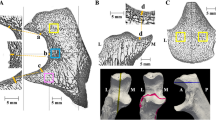Abstract
Purpose
The proximal ulna, particularly the course of the posterior border, has a complex three-dimensional (3D) morphology which has been highlighted recently due to its clinical relevance in relation to surgical treatments. 3D computed tomography (CT) reconstruction and computer-aided design (CAD) based software can help to visualize the complex anatomy and thus aid the investigation of the more detailed morphology of the proximal ulna.
Methods
In our current study, 3D CT reconstruction images of 20 cadavers were imported into the 3D CAD program. Three morphologic angle parameters of the proximal ulna were measured including the dorsal, varus and torsion angulation. The torsion angulation was measured using the flat spot of olecranon dorsal aspect. We measured the total length of the ulna and the distance between the olecranon tip and the apex of dorsal and varus angulation. Furthermore, the thickness of olecranon was also measured for all the specimens.
Results
The results showed that the mean dorsal, varus, and torsion angulation was 4.3° (range 2.6°–5.9°), 12.1° (range 7.9°–17.6°), and 22.5° (range 16.6°–30.5°), respectively. The average length ratio of the dorsal and varus angulation apex to the total ulnar length was 26.4 % (range 19.8–30.7 %) and 32.7 % (range 27.5–37.5 %), respectively. The average of olecranon thickness at the proximal tip, mid-olecranon fossa, and at coronoid tip level was 17.8 mm (range 14.1–22.8 mm), 19.7 mm (range 15.8–23.1 mm), and 35.1 mm (range 27.9–41.8 mm), respectively.
Conclusion
In conclusion, variations in the proximal ulna have to be considered when anatomically contoured dorsal plates are applied. Knowledge of the 3D morphologic anatomy of the proximal ulna would provide important information on fracture reductions, and the design of a precontoured dorsal plate or a prosthetic ulnar stem.





Similar content being viewed by others
References
Anderson ML, Larson AN, Merten SM, Steinmann SP (2007) Congruent elbow plate fixation of olecranon fractures. J Orthop Trauma 21(6):386–393
Brownhill JR, Mozzon JB, Ferreira LM, Johnson JA, King GJ (2009) Morphologic analysis of the proximal ulna with special interest in elbow implant sizing and alignment. J Shoulder Elbow Surg 18(1):27–32
Duggal N, Dunning CE, Johnson JA, King GJ (2004) The flat spot of the proximal ulna: a useful anatomic landmark in total elbow arthroplasty. J Shoulder Elbow Surg 13(2):206–207
Gere JM, Goodno BJ (2004) Mechanics of materials. 6th edn. Inner vision. Cengage Learning, Stamford, USA
Goldberg SH, Omid R, Nassr AN, Beck R, Cohen MS (2007) Osseous anatomy of the distal humerus and proximal ulna: implications for total elbow arthroplasty. J Shoulder Elbow Surg 16(3 Suppl):S39–S46
Grechenig W, Clement H, Pichler W, Tesch NP, Windisch G (2007) The influence of lateral and anterior angulation of the proximal ulna on the treatment of a monteggia fracture: an anatomical cadaver study. J Bone Joint Surg Br 89(6):836–838
Jung JW, Kang H-W, Kang T-Y, Park JH, Park J, Cho D-W (2012) Projection image-generation algorithm for fabrication of a complex structure using projection-based microstereolithography. Int J Precis Eng Manuf 13(3):445–449
Küçükdurmaz F, Saglam N, Ağir I, Sen C, Akpınar F (2013) Olecranon anatomy: use of a novel proximal interlocking screw for intramedullary nailing, a cadaver study. World J Orthop 4(3):130–133
Puchwein P, Schildhauer TA, Schöffmann S, Heidari N, Windisch G, Pichler W (2012) Three-dimensional morphometry of the proximal ulna: a comparison to currently used anatomically preshaped ulna plates. J Shoulder Elbow Surg 21(8):1018–1023
Rouleau DM, Canet F, Chapleau J, Petit Y, Sandman E, Faber KJ, Athwal GS (2012) The influence of proximal ulnar morphology on elbow range of motion. J Shoulder Elbow Surg 21(3):384–388
Rouleau DM, Faber KJ, Athwal GS (2010) The proximal ulna dorsal angulation: a radiographic study. J Shoulder Elbow Surg 19(1):26–30
Van Riet RP, Van Glabbeek F, Neale PG, Bimmel R, Bortier H, Morrey BF, O’Driscoll SW, An KN (2004) Anatomical considerations of the radius. Clin Anat 17(7):564–569
Wang AA, Mara M, Hutchinson DT (2003) The proximal ulna: an anatomic study with relevance to olecranon osteotomy and fracture fixation. J Shoulder Elbow Surg 12(3):293–296
Windisch G, Clement H, Grechenig W, Tesch NP, Pichler W (2007) The anatomy of the proximal ulna. J Shoulder Elbow Surg 16(5):661–666
Zhang S-J, To S, Cheung C-F, Du J–J (2012) Novel auto-regressive measurement of diamond tool wear in ultra-precision raster milling. Int J Precis Eng Manuf 13(9):1661–1670
Acknowledgments
This work was supported by the National Research Foundation of Korea (NRF) grant funded by the Korea government (MSIP) (No. 2010-0018294).
Conflict of interest
The authors declare that they have no conflict of interest.
Author information
Authors and Affiliations
Corresponding authors
Rights and permissions
About this article
Cite this article
Yong, W.J., Tan, J., Adikrishna, A. et al. Morphometric analysis of the proximal ulna using three-dimensional computed tomography and computer-aided design: varus, dorsal, and torsion angulation. Surg Radiol Anat 36, 763–768 (2014). https://doi.org/10.1007/s00276-014-1260-3
Received:
Accepted:
Published:
Issue Date:
DOI: https://doi.org/10.1007/s00276-014-1260-3




